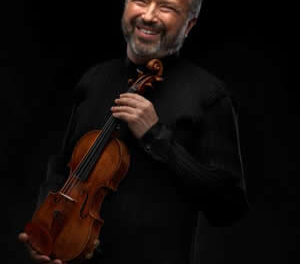The “Fifth Annual Concert of Music by Bill Robinson” (b.1955), held in Carswell Concert Hall at Meredith College, began with a thorough introduction by the composer himself, who earns a living as a physicist at North Carolina State University. This aspect made the concert more special; Robinson’s speech, along with his program notes, gave the audience an enriched background on the pieces. All compositions on the program were premieres, or at least they had never been performed with the same instrumentation before. The variety of instrumentalists also made the concert special – each of the four pieces was played by a different grouping of musicians. It was fascinating to see how each ensemble’s style compared with the others.
The first piece, Chamber Concerto for Piano Quintet (1984, rev. 2003 and 2013), was performed by a conglomeration of professional musicians from around North Carolina and beyond. The first movement, appropriately named “First Movement,” is fluid and suspenseful, with sections of ascending and descending scales played by violinists Eric Pritchard (of the Ciompi Quartet) and Mary Kay Robinson and violist David Marschall. Supporting these patterns, UNC Professor Emeritus Thomas Warburton completed the full sound at the piano, while cellist Virginia Hudson played chromatic bass notes, giving the movement an air of suspense. The following two movements continued with the abstract sound of the first, employing a great deal of chromatic motion and a constant shift of tonal center. The fourth movement, “Rondo Recidivisto,” is filled with strong chordal statements that showcased the musicians’ ability to match the rhythm of their differing phrases.
Robinson wrote the aptly named Robinsongs (2012) specifically for a family of musicians: oboist Joseph Robinson and his wife, pianist Mary Kay, along with their mezzo-soprano daughter, Rebecca. Coincidentally, they are of no relation to the composer himself. The movements of Robinsongs are settings of poems – two by Lewis Carroll and one by Ogden Nash. The whimsical limerick style of these poems is reflected in the tone of the music. In “Some Hallucinations,” flowing piano and oboe lines imitate the mind’s wanderings, along with an unpredictably leaping vocal melody. Rebecca Robinson’s resonant voice led well to the dramatic climax of “The Purist” on the line “eaten by an alligator.” This contrast of dramatic instrumentation with a more comical text was increasingly obvious with “You Are Old, Father William,” a poem detailing a man’s unconventional means of maintaining youth.
Of course, these three Robinsons are not just any family of musicians. Joseph Robinson, of Lenoir, NC, was the long-time principal oboe of the New York Philharmonic and former head of oboe studies at the Manhattan School of Music. Distinguished violinist Mary Kay Robinson played piano in the songs she and her husband had asked Bill Robinson to write for Rebecca, currently studying with baritone Sanford Sylvan as she pursues an advanced degree at McGill University.
The Art of the Violin, with movements written over a span of thirty-eight years, was performed by Duke violin professor Eric Pritchard and his students Roman Lin, Jenny Li, and Harish Eswaran. The serious and regal first movement contrasted with its title, “Just For Fun.” However, throughout the first and the following movements, the students’ ability to blend expertly together, despite having independent melodies, became apparent. The three students followed their professor through the uniquely beautiful chord progression of “Elegy for Izabela,” and the energetic jig-like rhythm of “An Original Traditional Melody.” (The second movement, composed in memory of violinist Izabela Speiwak, was the last section of this work to be completed.)
Sparked by a dream in which Elvis Presley (yes!) told Robinson to write a symphony inspired by the speeches of Martin Luther King, Jr., Birthday Symphony, Chamber Edition completed the evening’s music. (One may wonder about Elvis, but Robinson’s and MLK’s birthdays are the same: January 15.) The first movement, titled “How Long? Not Long” (a phrase taken from MLK’s speech of March 25, 1965), was meditative and interspersed with sections of forte urgency. The four musicians – pianist Thomas Warburton, violinist Xi Yang, clarinetist Fred Jacobowitz, and cellist Bonnie Thron – traded two-note phrases fluidly. In the second movement, titled after a Buddhist mantra, “Gate gate paragate parasamgate bodhi swaha,” the clarinet’s sound seemed unexpected against solemn chords in the string instruments. “August 28,” the title of the final movement and the date of the “Dream” Speech, seemed to tell a story, but it was an undefined story of organized chaos. The musicians built up the volume over sometimes startling phrases, but they all arrived together at the triumphant finale.
Updated 4/17/14: Robinson has posted the entire concert on YouTube. To see and hear the performances, click here.












